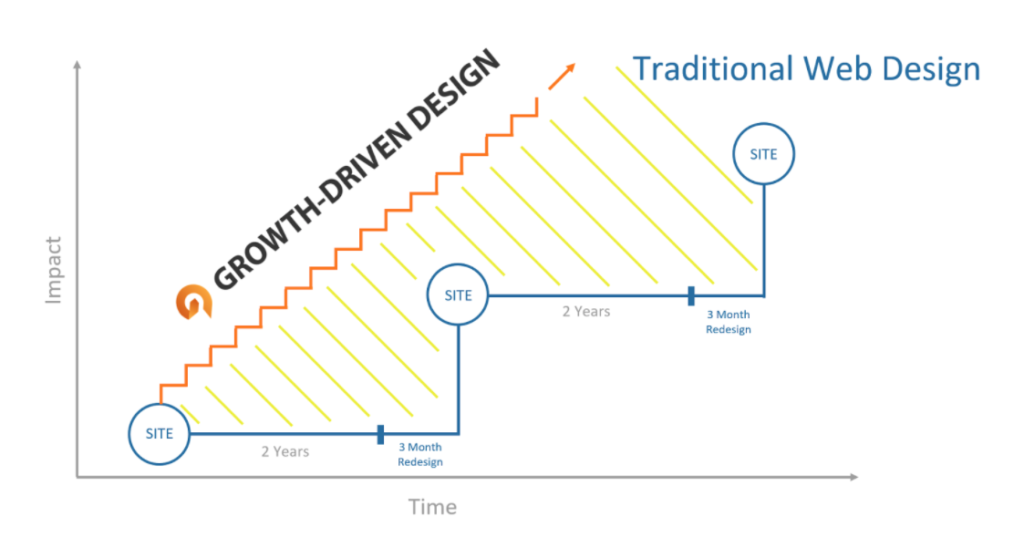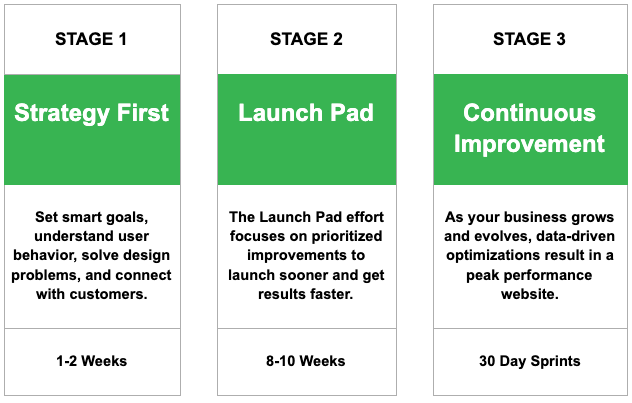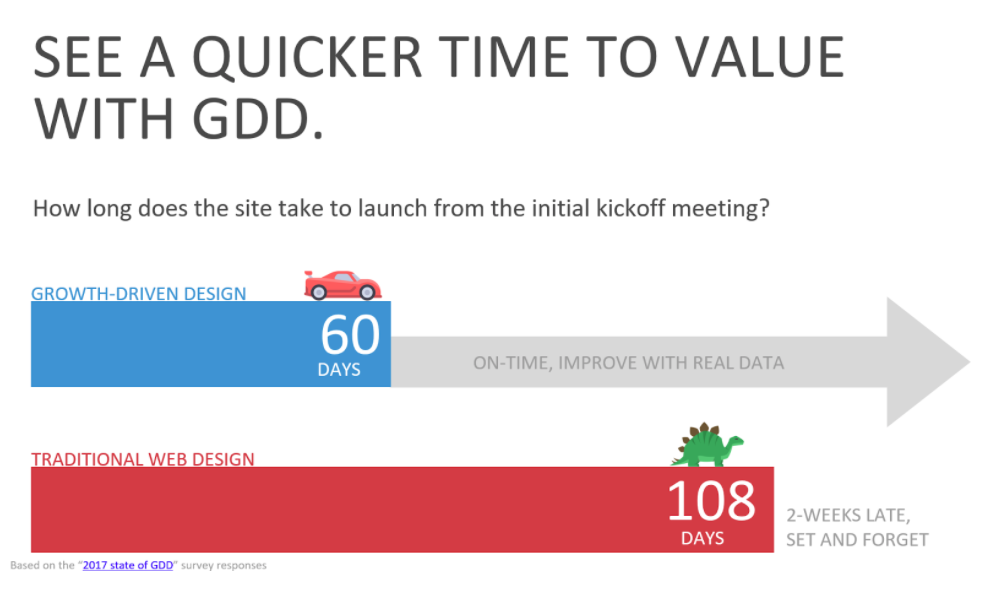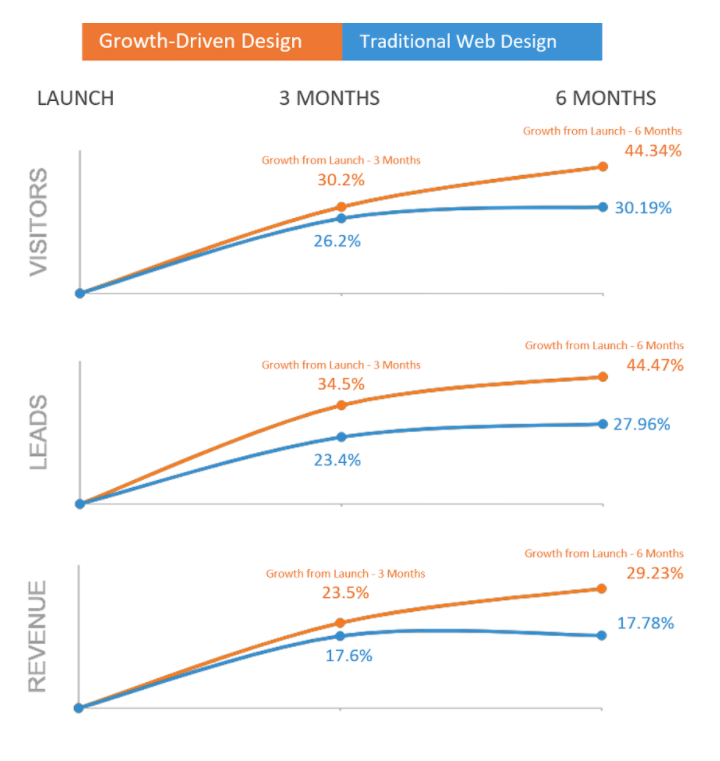How Growth-Driven Design (GDD) is turning Web Design on its Head
What is all the hype behind Growth-Driven Design (GDD) anyway?
Growth-Driven Design is a web design approach that helps eliminate many of the headaches caused by the traditional web design process and drive optimal results using data and continuous improvement principles.
The GDD process was developed to help companies mitigate risk and costs upfront, reduce time to market, and allow for ongoing continuous improvement. The major difference from the traditional web design process is that a website using GDD is Dynamic not Static. That difference lets us create a better User Experience and optimize business outcomes. We can do this by progressively optimizing the existing features and functionality, and adding new features and functionality throughout the lifespan of the site.
With traditional web design, a company typically waits until their website starts losing traction or becomes ineffective, then redesigns the whole website in one go- but doing it this way carries a large up-front cost and commitment of time, energy, and resources. Additionally, often these website resign projects run late and over-budget. This process also forces companies to make decisions about what to include based on popular trends without knowing what the real impact of those decisions will be. Any analysis of the website’s effectiveness has to be done post-launch, which may be too late to make meaningful improvements. In a 2016 HubSpot survey, 42% of marketers polled said they only make major or meaningful changes to their website once or less in a year.

The fundamental difference of the Growth-Driven Design (GDD) process includes:
- Minimizing Risk – One of the principal tenets behind GDD is mitigating the risk associated with designing a non-data driven website that leans on trends and decisions that are based on unproven hypotheses.
- Optimizing For Results – It’s better to release features that are rolled in a manner that both inform and are informed by experiences and learnings from the marketing and sales teams.
- Improving Continually – Your website should be continuously evolving and built in stages according to assumptions that are validated or invalidated based on data.
OK, that all sounds good, but how does it work?
With the GDD approach, the design and build process is broken into stages. Instead of taking months to completely finish a website, this approach focuses on starting with a launch pad website that has the essential content and information on it. Then, over time, developers implement the rest of the content in small and manageable chunks. The overall workload for a GDD website is spread out over several months, but delivers a product much sooner than traditional design.
By breaking the workload into smaller, more manageable pieces, every time you begin working toward a new goal, you have the ability to assess and evaluate so you don’t get trapped in one way of thinking. You are able to collect new data if needed and then proceed with the best possible information. All of your decision-making is focused on user data and test findings so you can create the best experience for the people who use your website.
The Three Stages of GDD design are:

What outcomes can you expect by using the GDD approach?
As they say, the proof is in the pudding. So, what benefits have other companies seen by using a GDD approach for their company website design? To that end, the creators of Growth-Driven Design surveyed 350 web design agencies about the impact GDD is having with their clients. The responses to this 2017 State of GDD survey really brought home the impact that adopting this new approach can have for a business’ bottom line- such as:
Staying within deadline
Website design and builds are infamous for running behind schedule and ultimately being launched later than originally promised. This all just adds to the risk involved with traditional website designs.
One of the big advantages of GDD is the turnaround time. Since a launchpad website gets built and launched quickly, the turnaround time is a fraction of what it would be with a traditional website design.

Realizing the website’s value more quickly
To piggy back on the previous point, a faster turnaround time can allow for a faster return on your investment and less downtime for your current website. The creation of a launchpad website has a much lower upfront cost, with greatly reduced risk. The risk of your website’s redesign is much lower because the launchpad will be built based on user tests and data instead of educated guesses and current trends.
Increasing business impacts
Perhaps the most impressive impacts reported in the survey are the overall increases to company leads and revenue. One of the reasons for this is because the company can measure exactly which changes are making the biggest impact, they’re able to keep and expand on those while ditching the changes that aren’t providing value.
According to the 2017 State of GDD survey, agencies that used Growth-Driven Design for their clients reported seeing 16.9% more leads and 11.2% more revenue after 6 months!

Insights from our own experience after taking the plunge
After implementing the GDD process with clients, we’ve seen great results. Here are some reactions from our team members about how GDD has changed how we are approaching our website designs.
“Growth Driven Design has allowed our clients to be more hands-on and collaborative. As our clients continue to learn more about their business/customers, we work together on improving their website to meet new and existing business directives.”
Kimberly Yount, Glide Project Manager
“Growth Driven Design is allowing our clients to be more agile in their website updates, responding to user needs more frequently. Clients are then able to validate that those new features and updates are actually working.”
Brooke Miceli, Director of Client Services
“The ongoing relationship that GDD fosters means we can test hypotheses on real users and quickly pivot if needed. More experimentation lets us understand our users better and discover what gets the best results.”
Ajia Leilani Wallace, UX Researcher
What do you want out of your next website redesign?
The truth of our world now is that it is a customizable one, where your customers’ experience with your brand is just as important as the products and services you provide. If you want to connect with your customers through your website design, you have to be responsive to what they need and how they want to interact with you in order to create that connection.

